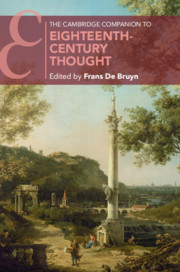Book contents
- The Cambridge Companion to Eighteenth-Century Thought
- Cambridge Companions to Literature
- The Cambridge Companion to Eighteenth-Century Thought
- Copyright page
- Contents
- Illustrations
- Notes on Contributors
- Chronology
- Lexicon of Terms
- Introduction
- 1 Philosophical Thought: Theories of Knowledge and Moral Thought
- 2 Science in the Long Eighteenth Century
- 3 Political and Legal Thought
- 4 Religious Thought: The Defence of Religious Establishment
- 5 Historical Thought
- 6 Wealth and Corruption: Eighteenth-Century Social and Economic Thought in Four Scandals
- 7 Literary and Aesthetic Theory
- 8 Sensibility: Passion, Emotion, Affect
- Further Reading
- Index
- Cambridge Companions To …
7 - Literary and Aesthetic Theory
Published online by Cambridge University Press: 15 June 2021
- The Cambridge Companion to Eighteenth-Century Thought
- Cambridge Companions to Literature
- The Cambridge Companion to Eighteenth-Century Thought
- Copyright page
- Contents
- Illustrations
- Notes on Contributors
- Chronology
- Lexicon of Terms
- Introduction
- 1 Philosophical Thought: Theories of Knowledge and Moral Thought
- 2 Science in the Long Eighteenth Century
- 3 Political and Legal Thought
- 4 Religious Thought: The Defence of Religious Establishment
- 5 Historical Thought
- 6 Wealth and Corruption: Eighteenth-Century Social and Economic Thought in Four Scandals
- 7 Literary and Aesthetic Theory
- 8 Sensibility: Passion, Emotion, Affect
- Further Reading
- Index
- Cambridge Companions To …
Summary
This chapter surveys the origins of aesthetics in eighteenth-century literary criticism, as major poets were examined in the light of concepts such as ‘beauty’. The treatment of art as a topic for moral thought gave a more polite, philosophical turn to the hitherto raucous and satirical character of early eighteenth-century critical practice. The chapter examines the development of thought about form and psychology encouraged by seventeenth-century French critics, followed by Addison, Shaftesbury, and later thinkers such as Burke, who presaged the gothic. Particular attention is given to Hume, Alison and Gerard, together with other Scots theorists of ‘belles lettres’. The discussion charts the increasing influence on criticism of such terms as ‘sublime,’ ‘taste,’ ‘genius,’ ‘originality,’ ‘imagination, and ‘art’ itself. An important element is the place of creative writers as aesthetic theorists, such as Pope, Joseph Warton, and Edward Young. Nor is the period’s greatest critic, Samuel Johnson, immune to the vocabulary of aesthetics. The contribution of visual artists is illustrated by the writings of Hogarth and Reynolds, while a final section examines theory’s relation to practice.
- Type
- Chapter
- Information
- The Cambridge Companion to Eighteenth-Century Thought , pp. 205 - 226Publisher: Cambridge University PressPrint publication year: 2021
- 1
- Cited by

